![]()

by Dr Ah Kahn Syed
I hope by now you all had chance to read Part 1. In case you haven’t it’s here.
You might want to make yourself comfortable for the next part, it’s not quick but it will be worth it.
To introduce where we are going next I’ll try and outline this in the way that a few memes have done during COVID, outlining the “safe and effective” claims that are rapidly being retracted
•It’s just a vaccine
•It stays in the arm
•It only lasts a few days
•It doesn’t integrate into the genome
•It’s not gene therapy
•There is no DNA in the vaccine
•It doesn’t go to the nucleus
•It’s safe in pregnancy and doesn’t go to the placenta
•It doesn’t stay in the arm, it goes everywhere but that’s a good thing
•There is plasmid contamination but it’s only in small doses and there is no evidence that it causes any harm
•OK, it goes to the placenta but that means that the baby is protected too-—[YOU ARE CURRENTLY HERE]—-
•OK it’s gene therapy but we’ve been using it for years and it’s been safe and effective with no adverse events identified after billions of doses.
•The LNP technology was brand new and hadn’t been tried but it’s been safe and •effective with no adverse events identified after billions of doses.
•The same technology can be used for CRISPR gene editing which is now approved by the FDA and in combination with the LNP technology can be used to provide a permanent vaccine that you never need to get updated with boosters and repeated ouchie injections
Because as we all know, it was really the 2 seconds of a needle prick that caused half the world’s population to reject the new therapy until the vaccine mandates kicked in and nothing to do with the fact that most people would have rejected a novel gene therapy if they knew what it actually was.

And yes, it was gene therapy however much the courts try and obfuscate the issue by claiming that doctors who not only were forced to take the product but were co-opted to administer the product under false pretences don’t have standing, and have now ended up on the receiving end of a judicial misconduct complaint.
And how do we know it’s gene therapy? Well because the FDA1, Moderna, BioNtech and every other institution that know what it actually is says so. From the 2024 FDA document (copied in the footnote):
Human gene therapy seeks to modify or manipulate the expression of a gene or to alter the biological properties of living cells for therapeutic use. FDA generally considers human gene therapy products to include all products that mediate their effects by transcription or translation of transferred genetic material, or by specifically altering host (human) genetic sequences. Some examples of gene therapy products include nucleic acids, genetically modified microorganisms (e.g., viruses, bacteria, fungi), engineered site-specific nucleases used for human genome editing, and ex vivo genetically modified human cells…. https://www.fda.gov/media/76647/download.
And yes, we discussed this previously but the point here is that we are going to get to this point soon:
“Yes it [the COVID vaccine] was gene therapy but nobody denied that and in any case 6 billion doses were given with no adverse events. And now we know that gene editing is equally safe.”
Because that has been happening all along. Gaslighting 101. Because novel pharmaceutical products are always going to be safe if you make sure that no research papers are allowed to talk about how unsafe they are, and you harass intimidate and threaten the doctors publishing said research.
So now that we have established beyond a reasonable doubt that gene therapy vaccines (GTVs) are safe and effective with no papers showing that they induce cancer via insertional mutagenesis or any of the other problems causing excess deaths that we are seeing in the real world, we can be happy that CRISPR gene editing, which provides a permanent solution to your gene problem, will be the ideal replacement for those ouchie repeated injections that were the real reason that people had “vaccine hesitancy” (other than institutionalised racism, of course)
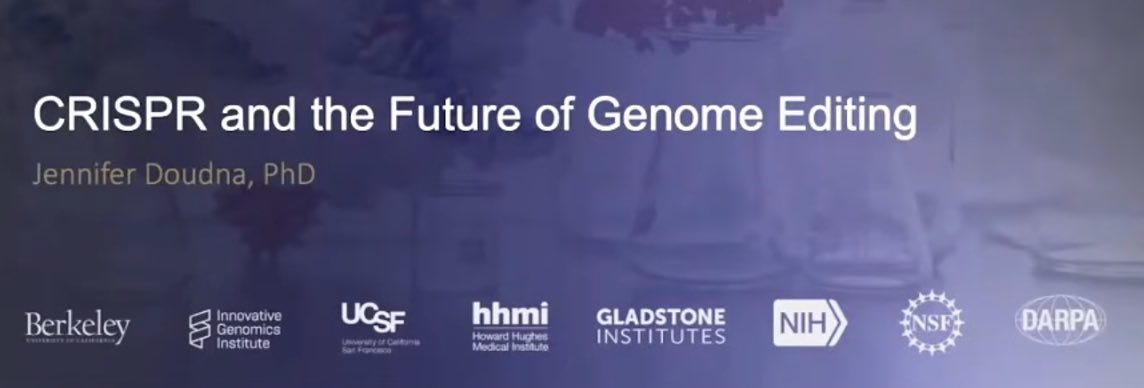
What the hell is CRISPR?
Well it’s nothing to do with bacon or chips or crisps or fried chicken although its name is clearly intended to conjure up some briefly-fulfilling emotion. It’s a technique for editing genes and genomes.
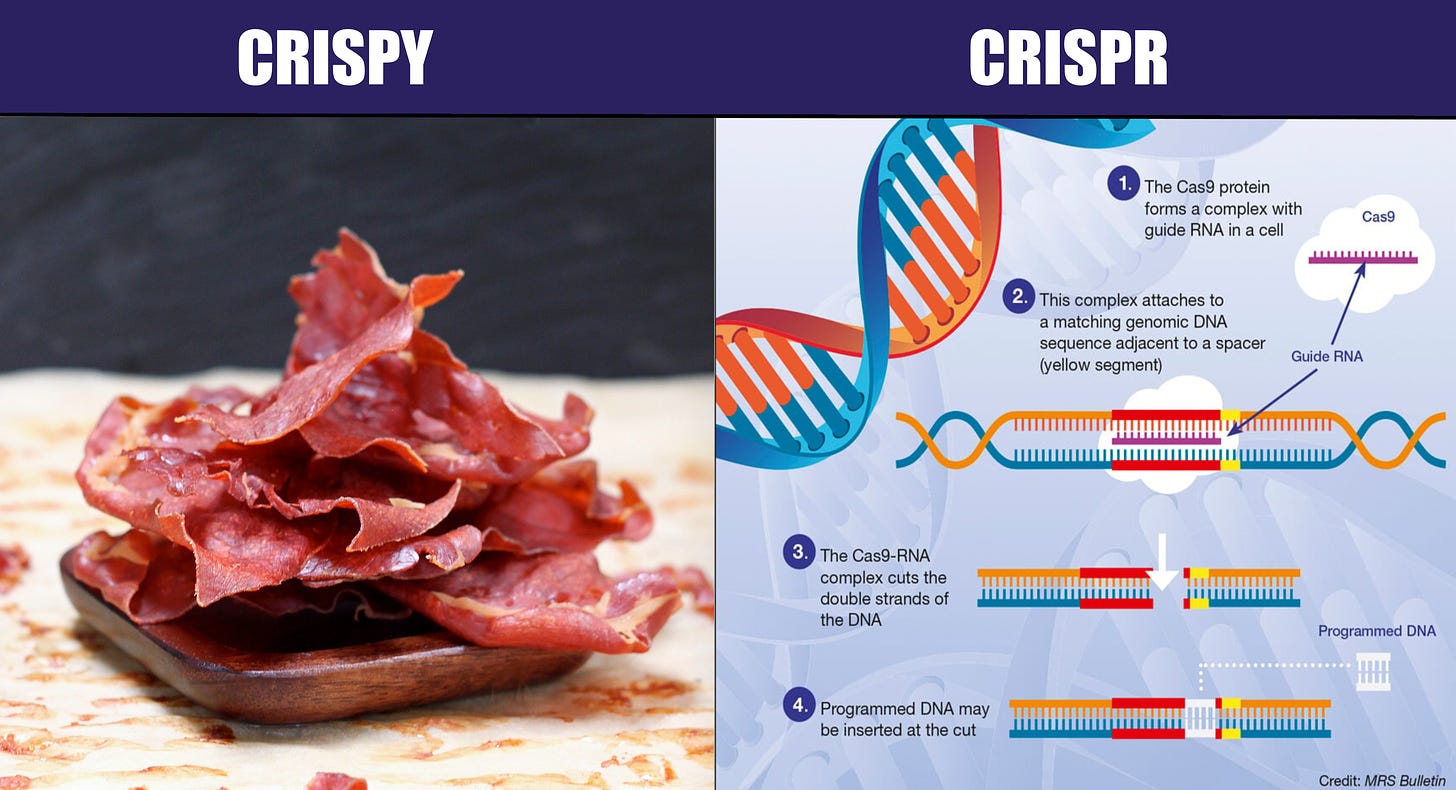
CRISPR stands for “clustered regularly interspaced short palindromic repeats” which relates to a specific pattern of DNA that are the target of the gene editing technique that also requires a “Cas” protein e.g. Cas9. The Cas protein forms a complex with a “guide RNA” to guide where the DNA is cut and once cut, new DNA can be added. Just like splicing a video tape in the old days.
Here’s a bigger version of the graphic above to explain it, from the Genetic Literary Project (which we will come to later)
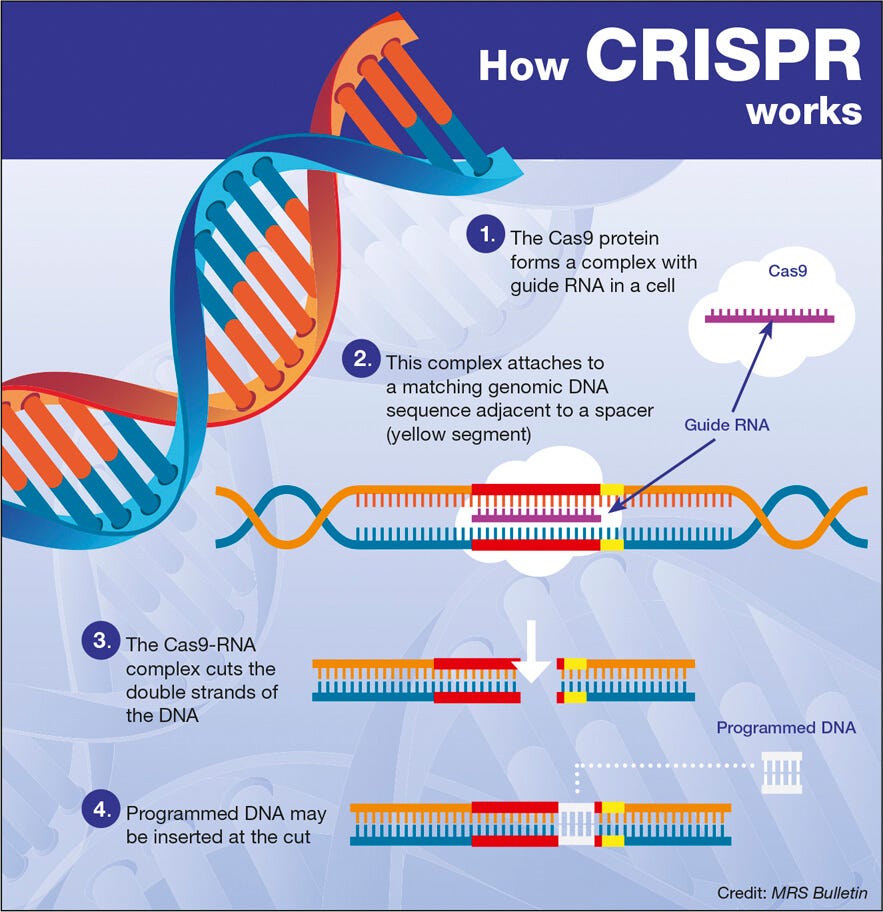
In the old days, CRISPR was reserved for editing genes in cells in the lab but as TheScience™ has advanced we now have the capacity to alter the genome of cells in vivo. That means, altering the genome in living organisms including humans.
And obviously it’s totally safe and effective – or at least that is what you will be told – because they found a way to check for all those pesky off-target (unintended) proteins that might arise from chopping up your genome whilst you’re still alive. And of course all the the known problems associated with in vivo CRISPR will have been ironed out already, just like they did the mRNA vaccines. Unfortunate though for the kids that already died due to immune responses or insertional mutagenesis:
Jesse Gelsinger, an 18-year-old with a mild form of the genetic disease ornithine transcarbamylase (OTC) deficiency, participated in a clinical trial which delivered a non-mutated OTC gene to the liver through a hepatic artery injection of the recombinant adenoviral vector housing the therapeutic gene. Unfortunately, Jesse passed away 4 days after treatment (7). The adenovirus vector triggered a much stronger immune response in Jesse than it had in other patients, causing a chain of multiple organ failures that ultimately led to his death (8). At the time of the trial, adenoviral vectors were considered reasonably safe. In preclinical development, however, two of the rhesus monkeys treated with the therapy developed a similar pattern of fatal hepatocellular necrosis (9). Shortly after, another gene therapy trial led to the development of leukemia in several young children induced by insertional oncogenesis from the therapy (10). These trials opened for two forms of SCID (SCID-X1 or common ɤ chain deficiency) and adenosine deaminase deficiency (ADA). The therapy used ɤ-retroviral vectors for ex vivo delivery of therapeutic transgenes to autologous CD34+ hematopoietic stem cells, which were reintroduced to the patients (10). Five patients developed secondary therapy-related leukemia, one of whom died from the disease (11). Further investigation revealed integration of the therapeutic gene into the LMO2 proto-oncogene locus, presumably resulting in the development of leukemia (12). Subsequent analyses have suggested a higher frequency of insertional mutagenesis events with ɤ-retroviral vectors relative to other vectors (13).
Of course CRISPR is so much fun that the Sasha lab designed a game to nudge you into believing that introducing it widely into the population would be a cool thing to do. Like dropping hot chips from the sky. I mean, who doesn’t like hot chips right?
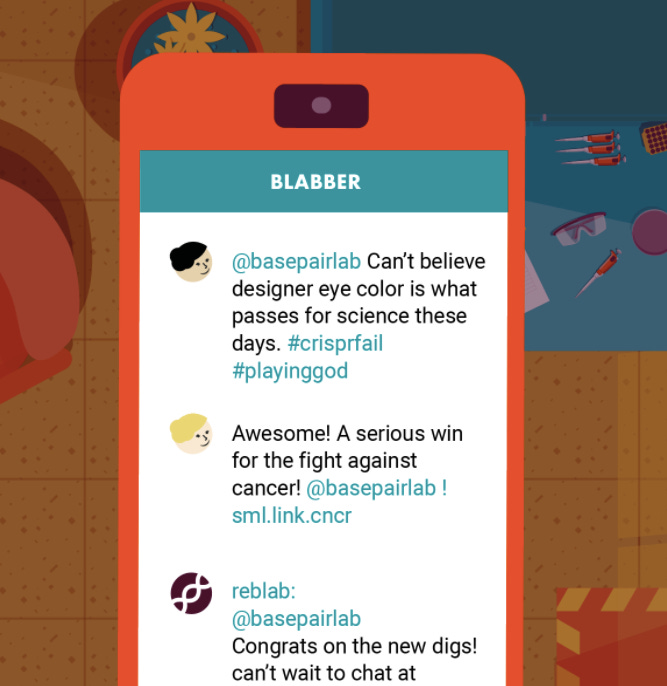
To quote from their article:
CRISPR — it’s one of those new science technologies that’s fun to talk about because who doesn’t want to to imagine a better future made possible by science? But whose version of “better” would prevail? The “what if’s” made possible by CRISPR gene editing technology are under intense debate by the international science community. Because these debates already affect policy decisions, the public needs to consider the ethical ramifications of what CRISPR could make possible.
Can you see the nudge here? Remember the greater good from Part 1?
Of course. Why would you NOT want to enhance the genetic pool of the world to make us all better humans, instead of those shitty humans we were yesterday, right?
And how similar does this graphic from the article about the Sasha lab game look to the trolley problem discussed in Part 1?
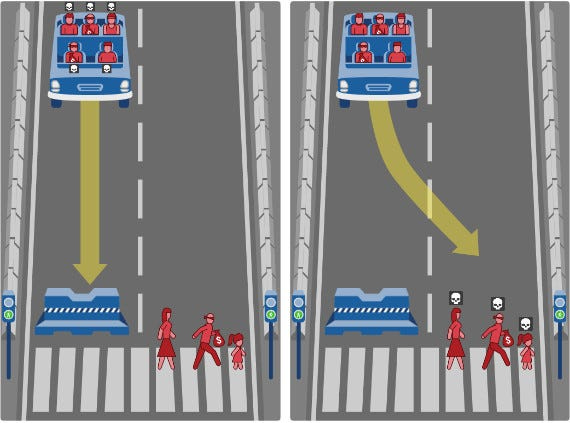
CRISPR needs a PAM
Getting back to the subject, essentially in order for CRISPR to edit your genes you need:
(1) a PAM2 and
(2) an RNA gene sequence matching the area of the genome you are targeting
The PAM is a tiny gene sequence (nGG where ‘n’ is any nucleotide e.g. CGG) that exists in multiple places of the genome. The RNA sequence is included to target any bit of DNA that you are interested in, provided it is next to a PAM. So you need a PAM and an RNA fragment. The most responsive PAM (of four options AGG, CGG, TGG and GGG) is CGG.
To see more about the PAM and how it works I would recommend 5 minutes on this fascinating video just showing how clever nature is, and how bacteria learnt to fight viruses using this genomic anti-viral defence mechanism.
If you’d rather just look at a graphic here it is showing the PAM and the “Guide RNA” or gRNA (the sequence that the scientist uses to match the sequence in your DNA that they want to cut)
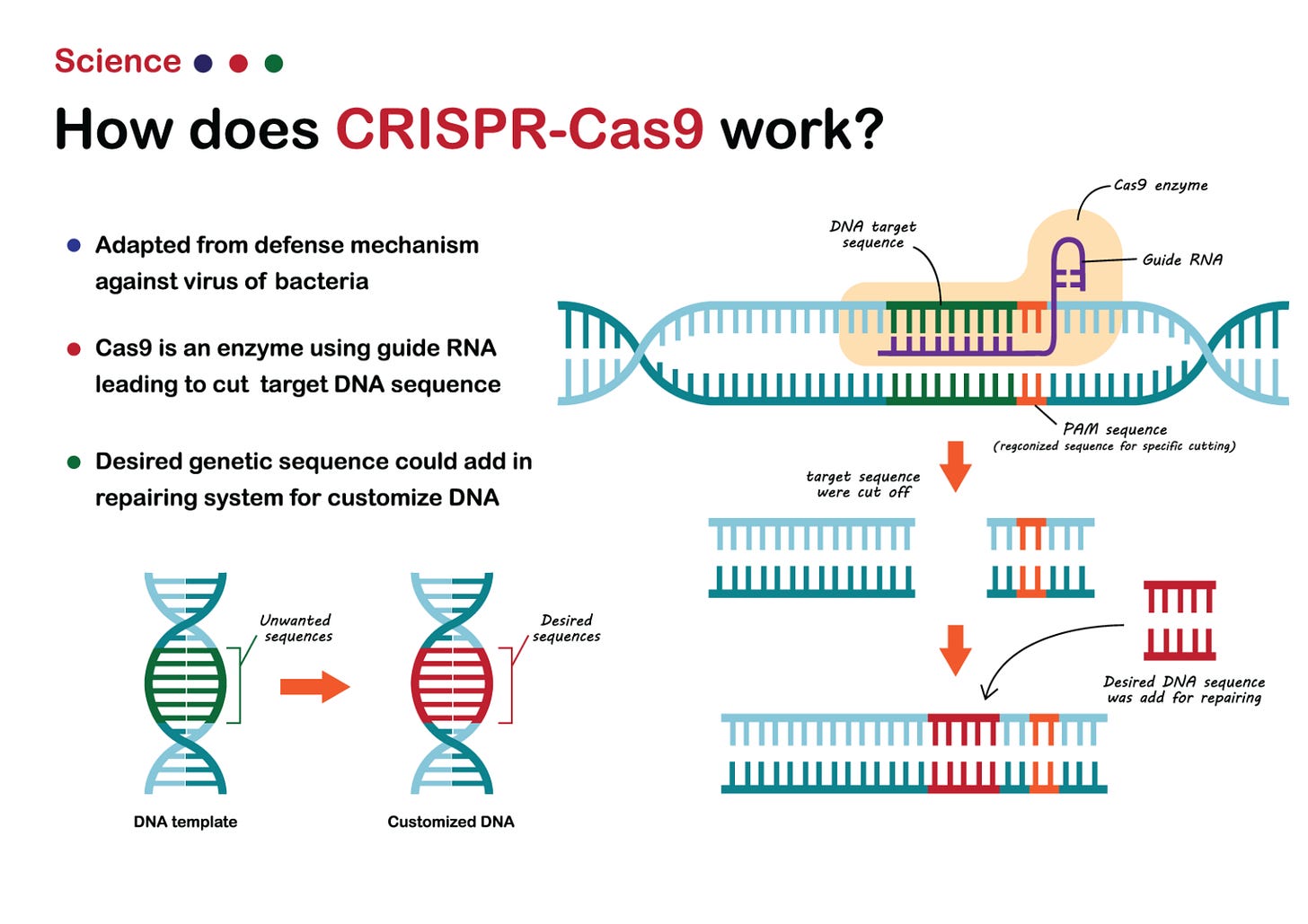
So if you want to edit the genome at a specific place you need to find a unique gene sequence next to a PAM site.
Well, you will now be pleased to know that the majority of the world has been provided such PAM sequences for free when they consented to receive a recombinant gene therapy vaccine courtesy of Pfizer, Moderna (and probably Novavax too3).
You see, those vaccines contain plasmids which are DNA and can easily integrate into your own cells’ DNA, as demonstrated by multiple authors but most recently Kevin McKernan and Hiroshi Arakawa who confirmed the integration of plasmid DNA into chromosome 12 and chromosome 9. I warned that this was likely here.

The great news about this integration event is that in both cases shown above, there is a CRISPR-Cas9 PAM sequence (CGG, AGG, GGG or TGG) in the sequence that has been integrated into the genome. This is fantastic news if you wanted to then subsequently edit the genome of the recipients of your drug at precisely the place you had previously added DNA!

And as it happens, the process of “codon optimisation4” of the gene sequence of the COVID vaccines (the process by which Pfizer, Moderna and Novavax decided to create a whole new 3822 nucleotide sequence that was different from the Wuhan Spike gene sequence yet supposedly produced the exact same amino acid sequence) produced a huge increase in the number5 of PAM sequences – particularly of the most efficient CGG type. What a lucky coincidence!

So the genomic integration event that has arisen out of what you thought was just a vaccine but turned out to be gene therapy has now conveniently provided the two necessary factors for subsequent gene editing – lots of PAM sequences and specific genome sequences that weren’t present in the human genome prior6.
In other words, 6 billion people are potentially now ready to be the recipient of a straightforward gene editing process that can replace your rusty old COVID vaccine sequence and replace it with a shiny new gene for pretty much anything.
Of course, because the people involved in the gene editing industry are super nice people they wouldn’t think to do such a thing would they?
Well let’s look at who they are… before we assume that they have all been acting altruistically.
The Corporate Behemoth of the Gene Editing Industry
It is essential to understand that gene editing is very expensive – upwards of $1million a pop. Bad news for the consumer but excellent news for the companies behind it who stand to make – not billions – but trillions of dollars if they can get this product into people like they did with the COVID vaccines.
And wouldn’t you just know it? When the COVID vaccines were flying off the shelves and before we were allowed to find out that they weren’t all they were promised to be, the price of the Big 4 CRISPR corporations’ stock went through the roof. Then came crashing down as fast when problems with the mRNA vaccines started to be noticed.

So who are the players behind these CRISPR corporations and the technologies that underpin them?
Well the biggest player is Jennifer Doudna, co-inventor of CRISPR.
Here she is talking about her utopian vision of the world, where elite scientists like her can edit the genome of cows to make them fart less, thus saving us all from climate change. No, I’m not kidding.
This is the important bit of what she says (from 5:14):
We know the poorest countries and people are the most affected by climate change, and it’s a problem created by the wealthiest people. And methane is a big part of the problem. It’s been a major contributor to rising global temperatures since preindustrial times. Specific microbiome compositions in livestock can actually reduce methane emissions by up to 80 percent. But doing that today currently requires daily interventions at enormous expense, and it just doesn’t scale. But with precision microbiome editing, we have an opportunity to modify a calf’s microbiome at birth, limiting that animal’s impact on the climate for its entire lifetime….
So our technology could really move the needle in our fight against climate change.
So Jennifer Doudna, the inventor of RNA and holder of an obscene number of patents potentially worth trillions of dollars wants to edit the genome of animals (and presumably “poor” humans) for political causes.
Great. Who’s next? (Don’t worry, this gets worse).
Here’s another group of scientists involved in normalising gene editing as just the same as any other medical treatment. Peter Singer wrote the foreword to the “Handbook of Bioethical Decisions7” which should be a guide for scientists not to step over the bounds of messing with humanity’s basic building blocks of life. Luckily Peter is also a co-author on this “controversial” article defending eugenics. Yes you read that right, defending eugenics.
Yay!

And his co-author Jonathan Anomaly wrote this edgy piece about how you can all be treated as “public goods”, which cleverly embraces the totalitarian ethos of “the greater good” with the concept of humans being public property (see Part 1).
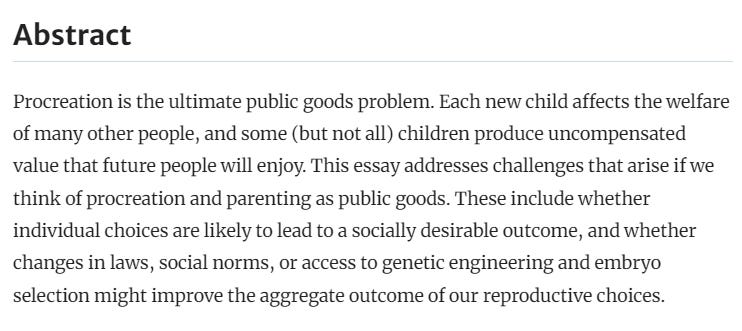
Fortunately for the world it is not just the Doudnas, Anomalys and Singers of the scientific world that are in charge of our genomes. The funding for much of this industry comes from none other than people like the infamous Jeffrey Epstein who literally tried to create his own eugenics retreat.

And here he is meeting with the eugenicists “genomic improvers” at Harvard, including leading CRISPR scientists George Church and Eric Lander (h/t Jesse Matchey, who was cancelled from twitter for 2 years for exposing this).
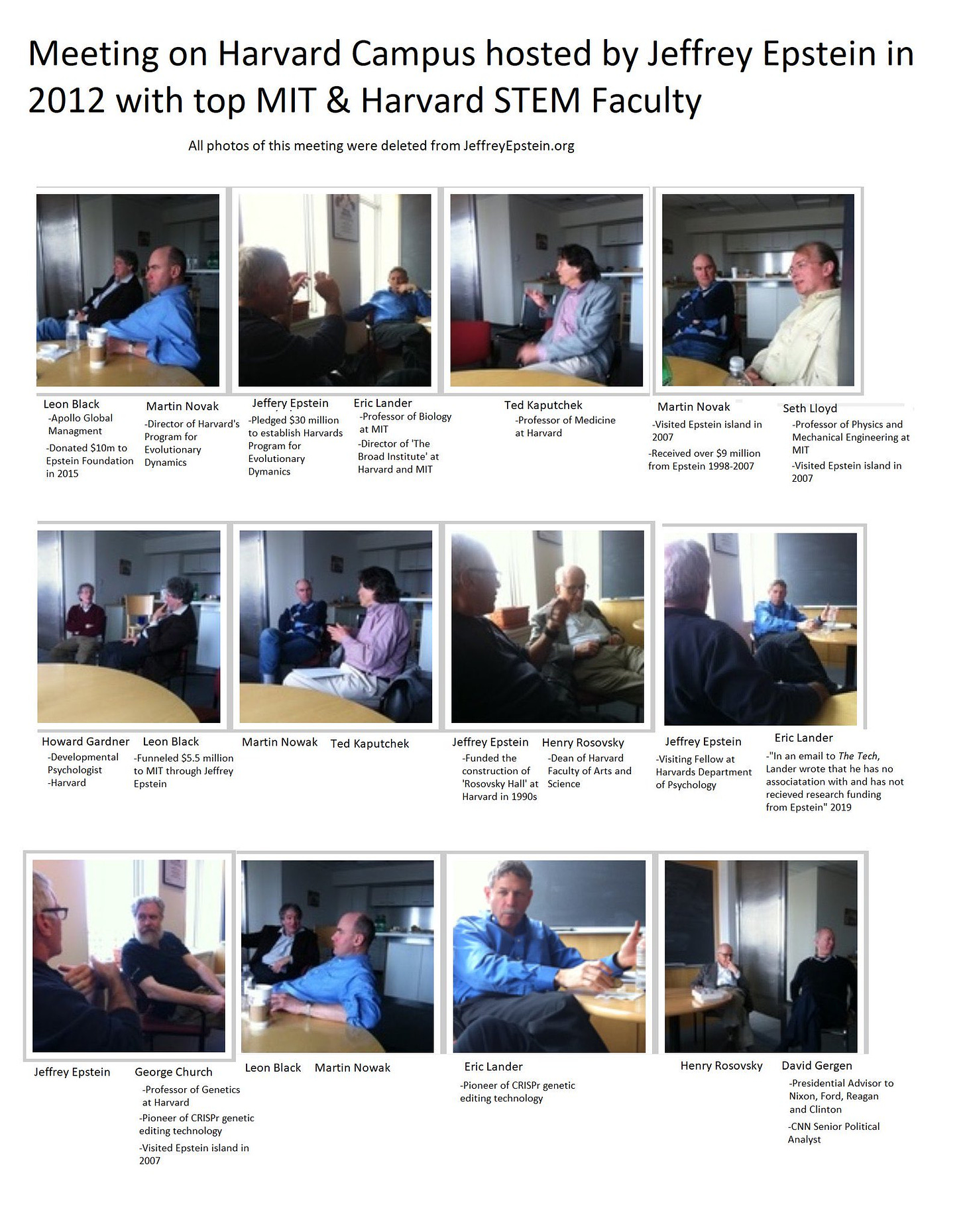
As ridiculous as it seems, Jeffrey Epstein founded and funded Harvard’s creepily named “program for evolutionary dynamics” – which for most people might be more reasonably named “eugenics program”. He spent a lot of time with people from the “Skeptics society” who you will have seen disparaging “Antivaxxers” on twitter. Their purpose is presumably to prop up the stock of the biotech companies, because if they were to allow dissenting scientists to speak freely on social media that stock would collapse.
The “Skeptics” include people like James Randi, who was part of a long running identity theft fraud that was eventually prosecuted, and Loren Pankratz who fraudulently claimed expertise in order to defend pedophiles in court8. The de facto leadership of the Skeptics movement passed to David Gorski who now runs a hate campaign via multiple blogs against people who try to speak out against the Epstein-Pharmaceutical conglomerates, as well as Richard Dawkins who has happily defended “mild paedophilia” again and again9.


Now we know what their doing with all those Aborted Fetuses